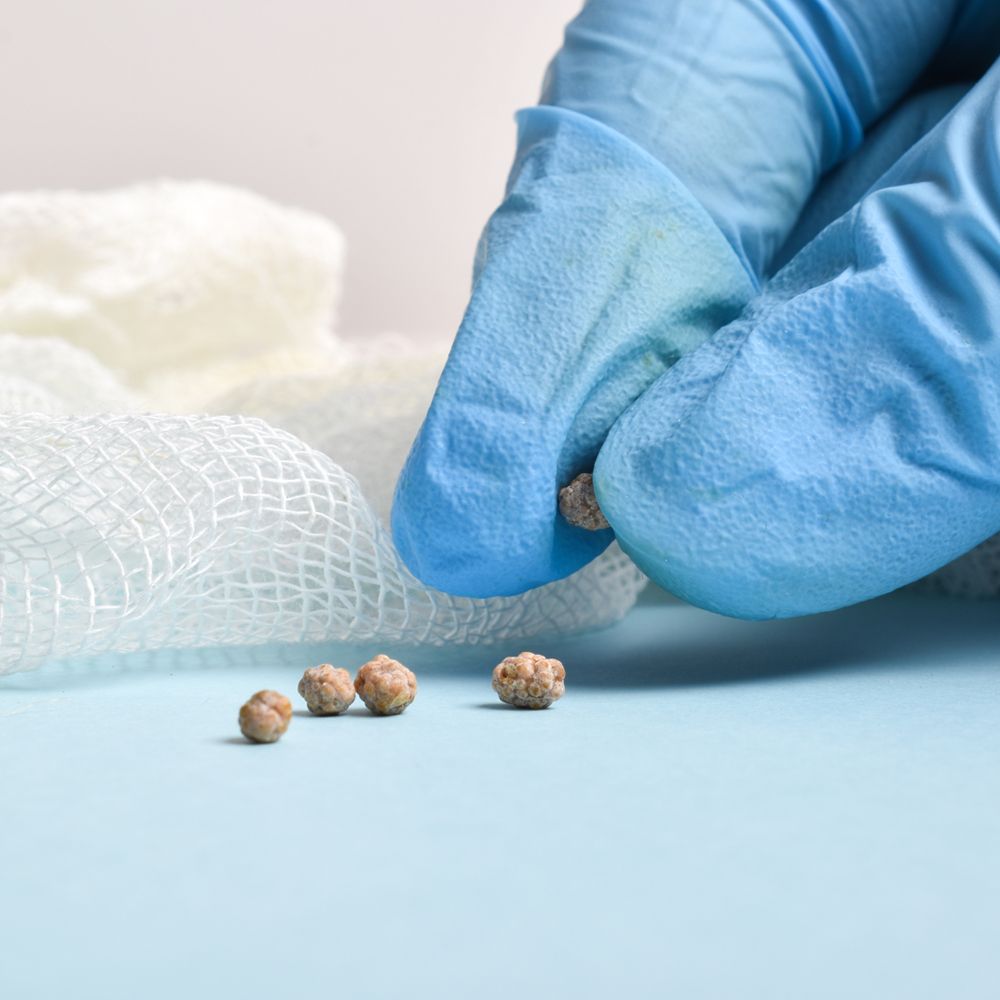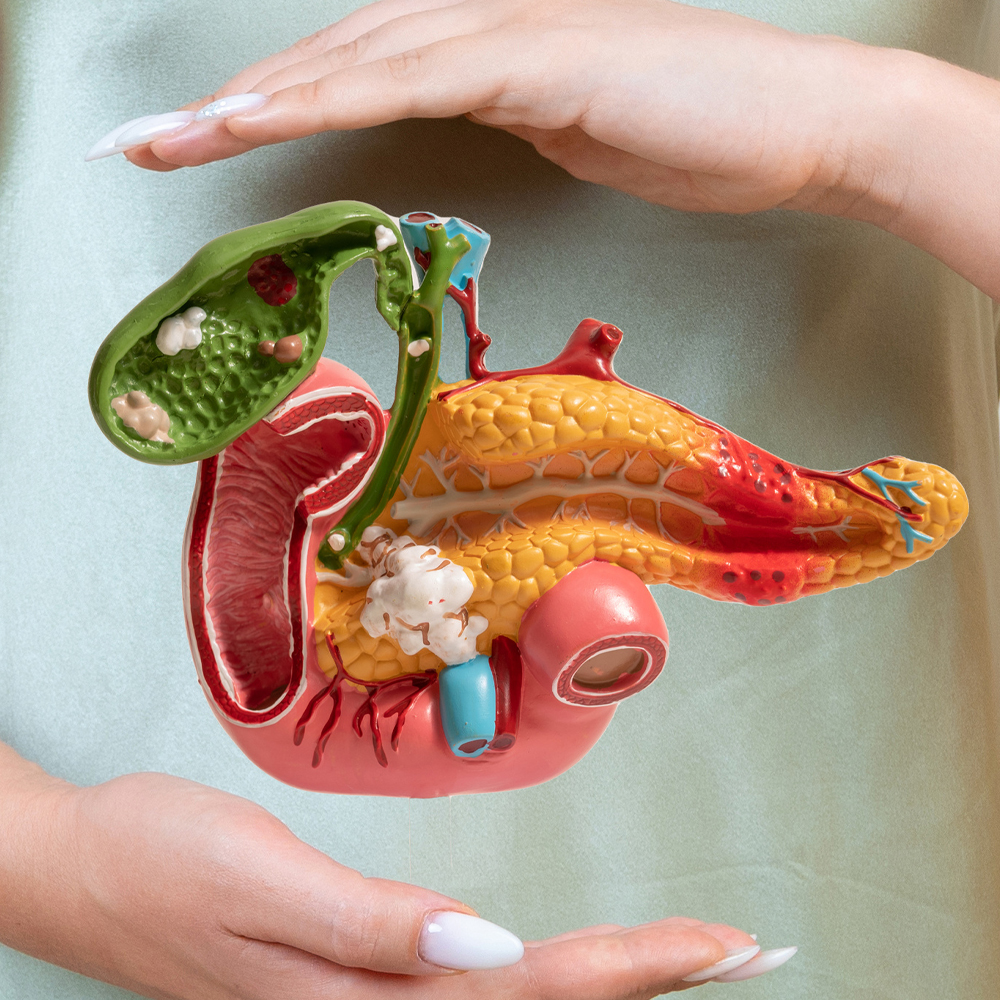This health information blog was written by Griffin Faculty Physicians General Surgeon Dr. Deepali Jain.
It’s late on Friday night. You finally lay down after a wonderful night of food and fun with friends and family. Your heart and belly are full, and you are ready for a restful sleep when you feel a sharp pain in your upper abdomen. You think it’s indigestion from overindulging. You scold yourself for over-eating, take some antacids and lay back down. The pain hangs around though. It’s sharp and stabbing under your ribs on the right side. It wraps around to your side and up to your shoulder blades. You’re nauseated, but don’t throw up. You toss and turn for a couple hours, and the pain finally subsides.
If this sounds familiar, you might be suffering from symptomatic gallstones.
Gallstones are much more common than you likely realize. In fact, 10-20% of American adults have gallstones. The majority (80%) are asymptomatic, yet more than 700,000 gallbladder surgeries are performed annually in the U.S. You may find that your family, friends or co-workers have been diagnosed with gallstones.
So, what is a gallbladder and gallstone exactly?
The gallbladder is a small, pouch-like organ that is part of the digestive system. It sits tucked under the liver in the upper-right portion of the abdomen and is attached to a branching system of bile ducts.
The bile ducts carry bile, made in the liver, to the intestines where it is used to help digest fats in our diet and eliminate waste products. Gallstones form inside the gallbladder when the components of bile get out of ratio, producing crystal-like stones. They can be small, sand-like sludge or a couple inches in size. Development of symptoms is not necessarily related to the size or quantity of stones.

Some risk factors for developing gallstones include being over 40 years old, being overweight or obese, high fat diet, family history of gallstones, rapid weight loss, and Native American or Hispanic ethnicity. Women are more like to get gallstones than men and they can be caused by hormonal factors such as pregnancy or hormone therapy. Gallstones can also be associated with other medical conditions such as diabetes, Crohn’s disease, liver disease, sickle cell anemia, and leukemia.
What are the symptoms of gallstones?
Many people who have gallstones will never or rarely experience symptoms. They often will find out about them incidentally on an ultrasound or CT scan done for some other reason. However, for the roughly 20% of people who do develop symptoms it can be quite bothersome.
The scenario at the beginning of this post is a very typical episode of biliary colic, sometimes called a “gallbladder/gallstone attack.” It occurs when a stone temporarily blocks the opening to the bile duct, causing obstruction of the gallbladder. It presents as upper abdominal pain, usually under the right rib cage, often stabbing or sharp in nature. It often comes on after eating, usually more related to heavier or fattier meals. Episodes often occur at night since we tend to eat our larger meals in the evening. Frequently, the pain will resolve on its own after 1-2 hours.
Sometimes episodes can come on with more severe, lasting pain that doesn’t resolve after a couple hours. These episodes can also include nausea, vomiting, fevers, and chills. Even after the more severe episode resolves, the pain can recur easily or persist as a dull ache – usually worse after eating. This is cholecystitis and it is caused by the stone becoming stuck leading to significant inflammation and possible infection. These worsened episodes often result in a visit to a hospital emergency department and sometimes require admission to the hospital for urgent treatment.
Sometimes gallstones can travel out of the gallbladder and cause blockage in the main bile duct or irritate the pancreas resulting in pancreatitis. These are more severe and urgent episodes. They can include severe pain, fevers, vomiting, jaundice (yellowing of the skin and eyes), dark amber urine, lighter/gray colored stools. These types of symptoms should be evaluated in a hospital emergency department right away.
How are gallstones diagnosed and treated?
The best test for identifying gallstones is usually an ultrasound. Other imaging tests include CT scan, a nuclear medicine test known as HIDA scan and occasionally an MRI. Blood work is used to evaluate for liver inflammation or blockage and infection.
 The usual treatment of symptomatic gallstones is to surgically remove the gallbladder – known as a cholecystectomy. Treatments such as medications or shockwaves to dissolve the stones are typically not used as they tend to be ineffective, and the stones will likely come back.
The usual treatment of symptomatic gallstones is to surgically remove the gallbladder – known as a cholecystectomy. Treatments such as medications or shockwaves to dissolve the stones are typically not used as they tend to be ineffective, and the stones will likely come back.
Surgical removal of the gallbladder leaves the main branches of the bile duct tree intact. This means that bile is still made in the liver and drains into the intestine via the main bile duct. Most people get back to a normal diet. There can initially be some changes in bowel habits especially when eating fatty foods, but these are typically short-lived and rarely require treatment.
Gallbladder surgery is done laparoscopically or robotically with four incisions in the abdomen that are a quarter to half an inch. It is done under general anesthesia, and usually does not require an overnight stay in the hospital. You’ll feel sore and tired for the first week or so after surgery, and people feel nearly back to normal about two weeks later.
While gallbladder surgery is very safe, all surgeries do carry some risks. Your surgeon will discuss these in detail with you during your consultation. If appropriate, your surgeon may recommend using a robotic surgery instrument.
About Griffin Faculty Physicians General Surgery
At Griffin Faculty Physicians General Surgery, we recognize that anytime you’re not feeling your best, it can disrupt your life and leave you feeling anxious and uncertain. We want you to be well- informed and feel confident in the care you are receiving. You will meet with the surgeon who will perform your surgery in advance and review your health information and their recommendations. They will address any of your concerns or questions in detail.
Griffin Faculty Physicians General Surgery is a team surgeons and caregivers with decades of experience in treating gallstones and many health conditions. Our patient-centered focus ensures that your health and comfort are our top priority, including an expedited appointment process for routine visits, personalized treatment plans, and our commitment to safe, exceptional care in an advanced, state of the art operating room at Griffin Hospital.
If you are experiencing symptoms of gallstones or have additional questions, contact your primary care provider or Griffin Faculty Physicians General Surgery at 203-732-3443.
